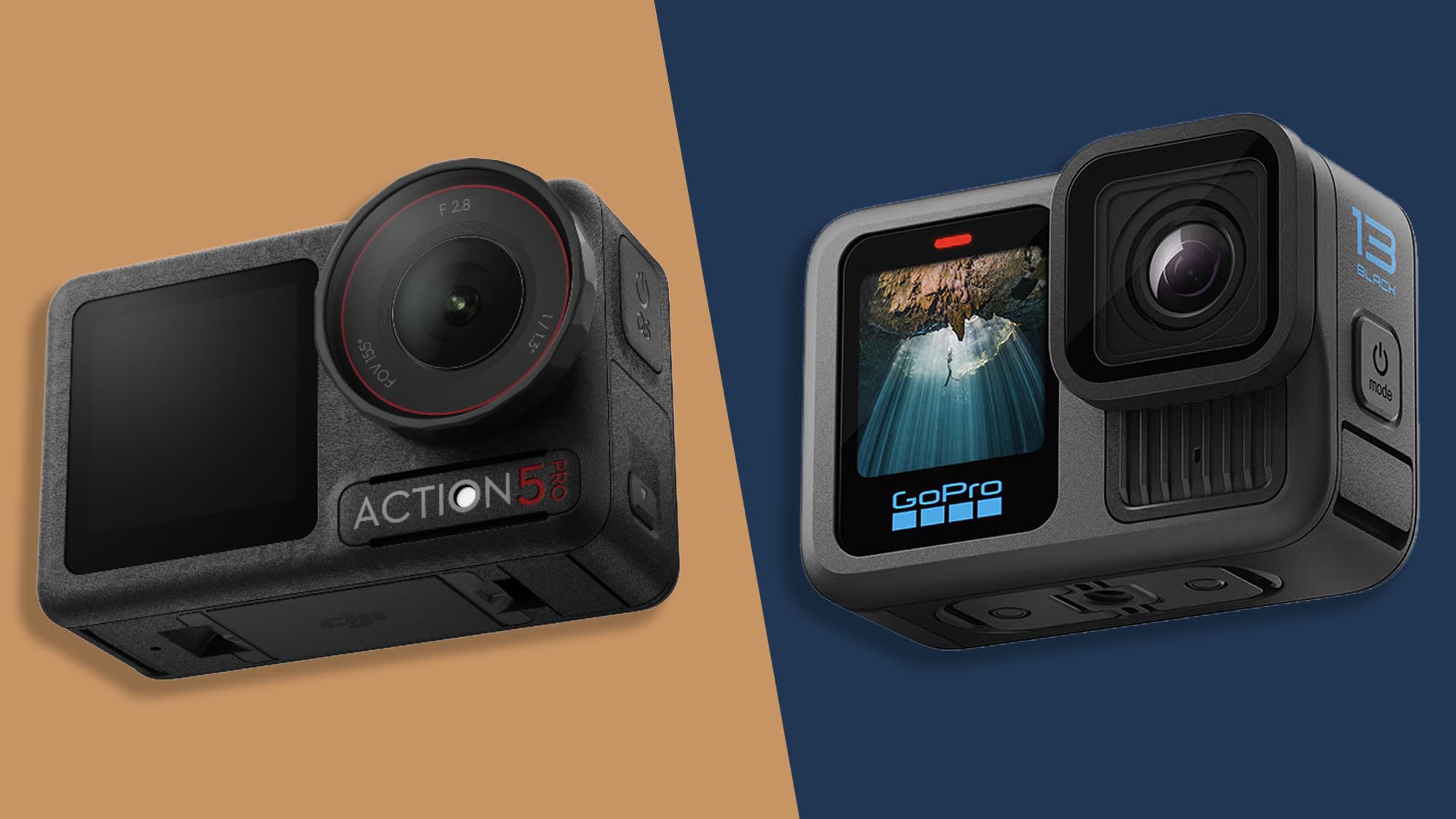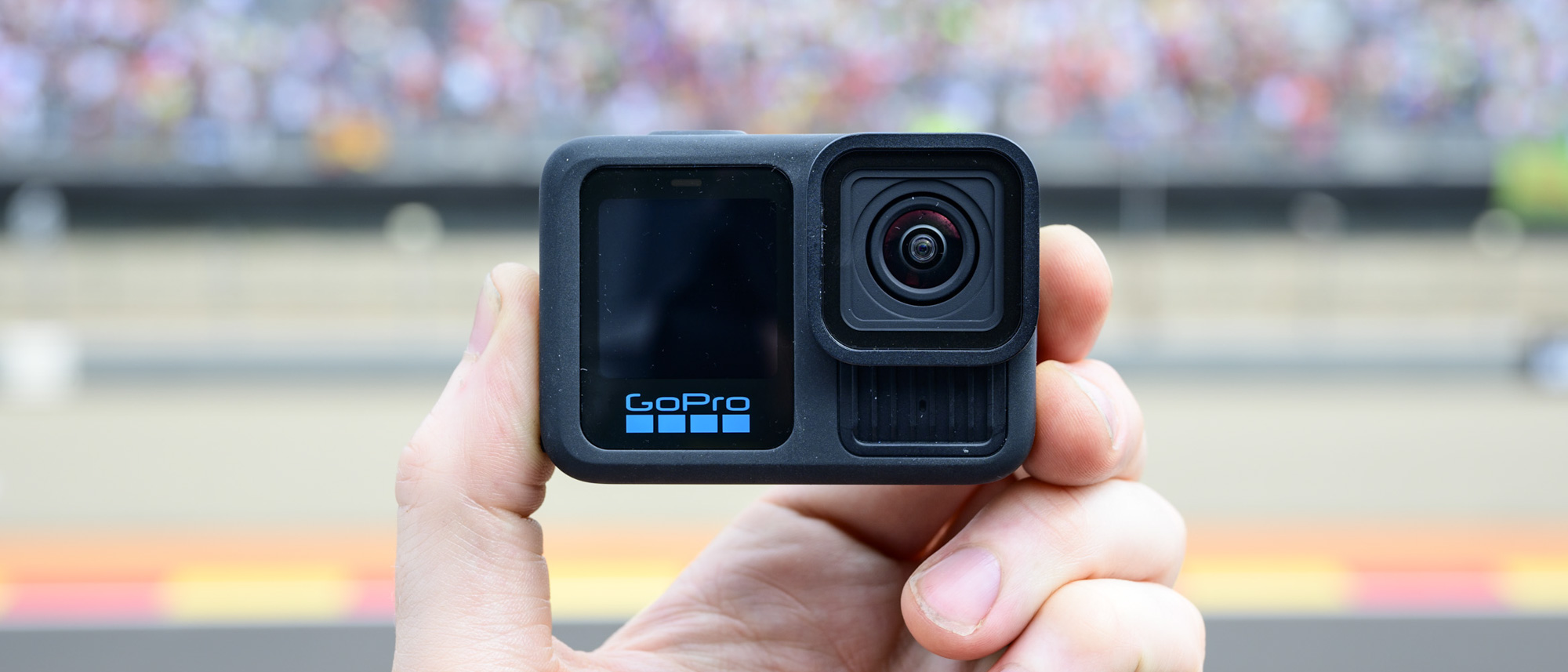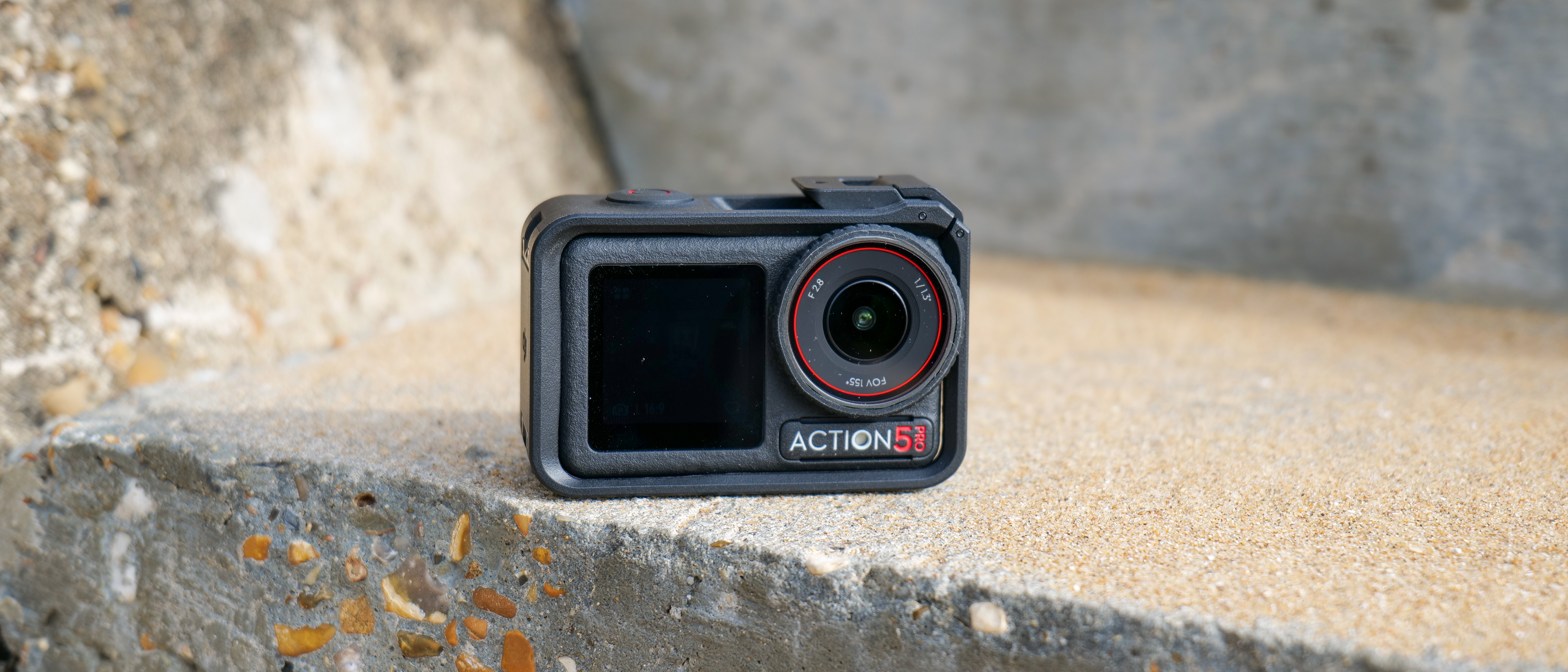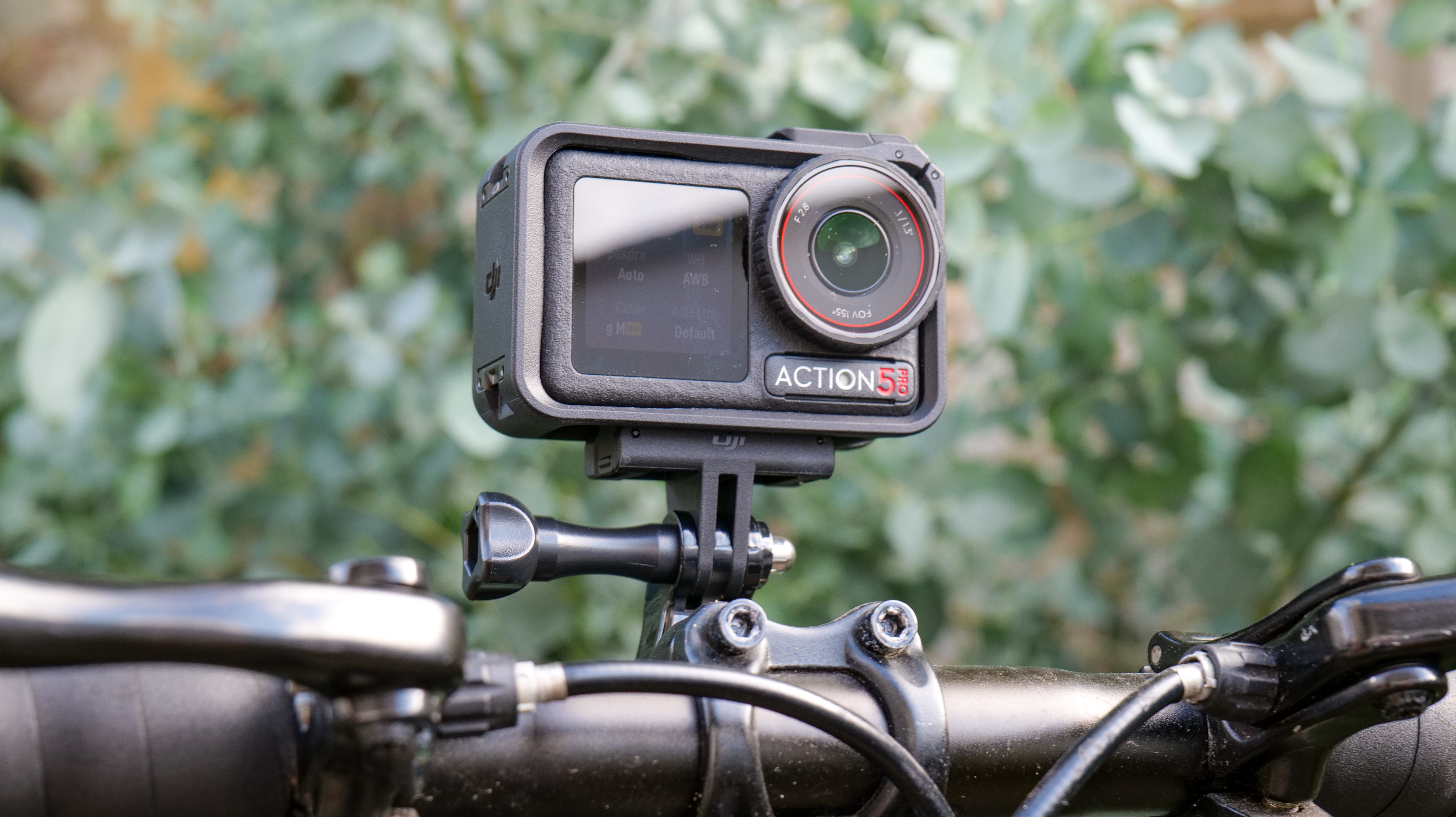GoPro Hero 13 Black vs DJI Osmo Action 5 Pro: has DJI dethroned GoPro?
Two flagship action cameras from two of the biggest names, but which one is best?


Same sensor and no 8K, but the new Lens Mods design is a win
Pros
- Superb range of accessories, including new auto-detected Lens Mods
- Improved battery life and heat dissipation
- Excellent-quality 5.3K video
- Decent Quik app for quick edits
Cons
- Sensor and video resolution unchanged from predecessor
- Image quality of Insta360 rival remains better in low light
- Processing time needed for slow-mo videos
- Additional cost of Lens Mods adds up

A worthy GoPro Hero 13 Black rival offering excellent features and battery life
Pros
- Good dynamic range and detail
- Dual OLED screens
- Waterproof to 20m without case
- Long battery life
- Works superbly with DJI Mic 2
Cons
- No 5.3K+ or 8K video option
- SuperNight mode is merely okay
- Lacks the lens accessories that the Hero 13 Black enjoys
Just a few short years ago, GoPro seemed the only serious option for folks who needed a reliable, small action camera. That has changed. Rivals like Insta360 and DJI have shaken things up. And, as you’ll see in this comparison, the DJI Osmo Action 5 Pro takes some bold and transparently aggressive technical strides ahead of the current champ GoPro Hero 13 Black.
It has a bigger sensor, better water resistance, larger and more contrasty displays, longer battery life and more. So is it KO for GoPro? Not quite. For some the new HB-Lens series will make the semi-modular GoPro Hero 13 Black a more versatile creative tool than the Osmo Action 5. Let’s dig in.

1. GoPro Hero 13 Black vs DJI Osmo Action 5 Pro: price and availability
- Hero 13 Black from $399.99 /£399.99 /AU$649.95
- Osmo Action 5 Pro from $349 /£329 /AU$599
Just a fistful of days separated the releases of these action camera heavyweights. The GoPro Hero 13 Black was out first, announced on September 4 before a retail release later that month. It costs $399.99 /£399.99 /AU$649.95. The DJI Osmo action 5 was announced two weeks later on September 19, and the Standard bundle costs $349 /£329 /AU$599.
Both cameras are available in pricier bundles with accessories such as additional batteries and grips, such as the Osmo Action 5 Pro Adventure Combo ($449 /£409 /AU$769) and the Hero13 Black Accessories bundle ($449 /£449.99 / AU$729.95. As you can see, which one is better value depends on the bundle that you want and the region that you live in. However, overall the Osmo Action 5 is a tad cheaper.
- Price winner: DJI Osmo Action 5 Pro

2. GoPro Hero 13 Black vs DJI Osmo Action 5 Pro: design and displays
- Hero 13 Black: twin LCD screens, main screen is touch sensitive
- Osmo Action 5 Pro: twin OLED screens, both touch sensitive
GoPro may have cemented the design template for the modern action camera, but DJI actually beat it in one respect. Dual screens are a new norm, as established in the original 2019 DJI Osmo Action. GoPro followed a year later with the Hero 9 Black.
The GoPro Hero 13 Black and DJI Osmo Action 5 both have this vlog-friendly dual-screen arrangement. But, again, DJI pushes a little more aggressively in how they are used.
Both front and rear display have touchscreens, where only the back one is a touch control in the GoPro Hero 13 Black. You are, as before, expected to use the shutter button up top to start and stop recording with a GoPro.
Sign up for breaking news, reviews, opinion, top tech deals, and more.
The style of display used is arguably a bit more cutting-edge in the DJI Osmo Action 5 too. Both panels use OLED tech, where each pixel is a separate light source. GoPro, as usual, uses LCD panels in the Hero 13 Black.
You’ll notice the difference when shooting at night in particular. Such conditions show off the raised black floor of LCD, and how the entire screen glows when displaying any content.
OLED also allows for the Osmo Action 5’s always-on mode, which displays certain stats when the camera’s not in direct use. This is what the front GoPro screen used to be all about back in the GoPro Hero 8 Black days, funnily enough.
What matters most in an action camera, though, is brightness. To compete with direct searing sunlight we need the brute force of a high nit count (a measure of brightness). Both cameras are fairly strong on this count.
DJI notes the Action 5 also has great colour depth, covering 100% of the DCI-P3 standard. It’s nice, but we’ll worry more about colour in the edit than when trying to frame a shot, thanks.
We do appreciate the larger size of the DJI’s rear screen, though, at 2.5in to the GoPro’s 2.27in.
- Design and displays winner: DJI Osmo Action 5 Pro

3. GoPro Hero 13 Black Vs DJI Osmo Action 5 Pro: accessories
- Hero 13 Black: HB-series of lenses and filters
- Osmo Action 5 Pro: seamless DJI Mic connectivity
The design strength of the GoPro Hero 13 Black is found not in the basics, the specs, but in how GoPro has embraced accessories.
You can change the lens of the camera, and a handful of them are available from GoPro. These HB-series lenses include a macro with focus ring, an ultra wide, anamorphic (due in 2025) and an ND filter.
The Hero 13 Black front lens protector can be removed, so you’re not just plugging in another component on top of the standard front element — like the aftermarket lenses for an iPhone, for example. Your initial assumption might be this will open up a whole new world of third-party accessories, but there’s a complicating factor here.
A GoPro Hero 13 Black can detect these first-party lenses, meaning Garmin retains control over the ecosystem. That’s what’s truly different this generation — the GoPro Hero 12 Black had a super-wide-angle MAX lens mod too, but there was no smart factor to it.
The GoPro can become multiple cameras, in a manner reminiscent of Insta360’s modular One R series. There isn’t such a system for the Action 5, meaning any comparable solutions will have to be a third-party cludge.
One accessory in DJI's favor that feels slicker is its effortless bluetooth connectivity with DJI Mics. GoPro also offers this function, but with third party mics and the process isn't as streamlined.
- Accessories winner: GoPro Hero 13 Black

4. GoPro Hero 13 Black vs DJI Osmo Action 5 Pro: sensor and lens
- Hero 13 Black: 27MP, 5.3K video
- Osmo Action 5 Pro: Up to 40MP, 4K video, larger 1/1.3-inch sensor
DJI can claim technical superiority in the specs of the Osmo Action 5’s sensor. This is a respectably large 40-megapixel 1/1.3-inch sensor, which DJI claims can provide up to 13.5 stops of dynamic range. That’s high enough to make us assume there’s some clever software jiggery-pokery involved.
While the sensor is of the same size as the Action 4’s, it is a “next generation” design according to DJI, and larger than the GoPro’s sensor.
The GoPro Hero 13 Black has a smaller 27-megapixel 1/1.9-inch sensor, just like the previous year’s model.
DJI’s larger sensor will get you better low-light image quality and greater native dynamic range. However, DJI doesn’t offer the dedicated HDR modes you get in the Hero 13 Black.
GoPro’s camera has both standard HDR and HLG HDR modes that combine a pair of exposures to construct each frame — a handy way to eliminate those annoying blown highlights in bright clouds.
The DJI Osmo Action 5 hits back once again with higher resolution, 40MP to the GoPro’s 27MP. While we’ve heard no official word on this, we expect DJI to use a Quad Bayer design, like those of just about every phone sensor with such a high resolution. That would also be consistent with the Action 5’s solid (for an action camera) low light performance.
DJI’s last-gen Osmo Action 4 had a 10MP sensor. Quadrupling the resolution without using a pixel binning-ready Quad Bayer sensor? You’d be asking for trouble.
- Sensor and lens winner: Tie

5. GoPro Hero 13 Black vs DJI Osmo Action 5 Pro: battery life
- Hero 13 Black: 1,900mAh battery with up to 2.5 hours record time
- Osmo Action 5 Pro: 1,950mAh battery with up to 4 hours record time
When the GoPro Hero 13 Black arrived, improved battery life was one of the changes we found most striking. Its 1900mAh battery is rated for up to 2.5 hours of 1080p recording, up to 1.5 hours at 5.3K.
DJI has rather blown these numbers out of the water, despite using an only marginally higher-capacity 1950mAh cell. It says the Osmo Action 5 can last up to four hours of 1080p shooting. This is with stabilisation engaged, but Wi-Fi and the screens off.
How? A lot of it is likely a simple case of smart and efficient engineering, but the Osmo Action 5 also has a much more up-to-date processor architecture than the GoPro. It has 4nm (nanometer) transistors, where the GoPro GP2 is a 12nm chip — assuming GoPro didn’t upgrade the architecture without telling anyone. Smaller transistors offer the potential for greater power efficiency.
Just as important for many, the DJI Osmo Action 5 battery charges a bunch faster too.
- Battery life winner: Osmo Action 5 Pro

6. GoPro Hero 13 Black vs DJI Osmo Action 5 Pro: modes and features
- Hero 13 Black: 10m waterproof, 2.7K video at 240fps, 400fps slow-mo at 720p
- Osmo Action 5 Pro: 20m waterproof, 47GB of built-in storage
DJI went down a slightly unexpected avenue with one of the Osmo Action 5’s key upgrades. Its water resistance is rated at 20M depth, twice that of the GoPro Hero 13 Black (10M). And you don’t need a case to achieve that.
It’s still not at the level of a proper waterproof case — GoPro’s own is rated for 60m-equivalent pressures — but does provide additional peace of mind if you want to get a little more ambitious while out snorkelling.
There’s even a depth gauge built into the Osmo Action, and it’s compliant to the EN13319 standard, meaning you’ll be able to actually trust its readings. Do we need a depth gauge for snorkelling in the Maldives? Absolutely not, but it can also be used to make the DJI Osmo Action 5 start and stop shooting automatically when entering/leaving the water.
There’s generosity in the DJI Osmo Action 5 storage too. Ever head out with your action camera only to find there’s no microSD inside? We have. DJI provides insurance, by offering 47GB built-in storage. We presume this is the leftovers of a 64GB chunk of solid state system storage, after the operating system has had its share.
GoPro does claw back from credibility in its slo-mo capability and general shooting modes.
As usual, it tops out at 5.3k resolution where the DJI Osmo Action taps out at 4K. The Hero 13 Black can shoot at up to 240fps in both 2.7K and Full HD resolutions, while the native 240fps shooting of the DJI Osmo Action is limited to Full HD.
Burst slo-mo can head further too, up to 12x at 900p resolution or 13x speed at 720p, for up to 15 seconds. While DJI plans to add shooting modes up to 960fps to the Osmo Action 5, this will be based on interpolation, which is where additional frames are synthesised.
It’s kinda slo-mo cheating, and points to the reality that GoPro’s camera sensor, while not technically superior in some core respects, does have more what feel like “made for purpose” drive modes. DJI has one last riposte, though, saying its new processor allows it to follow a subject, cropping in and effectively digital panning. It’s a form of auto editing of most interest to very casual shooters and those with little time to edit, but it’s a nice idea regardless.
- Modes and features winner: Tie

Early verdict
DJI plays hardball with the Osmo Action 5 Pro, focusing on overtly new features and upgrades in a way GoPro has not in at least its last couple of generations.
It isn’t quite enough to get over the sense action cameras have hit a sort of plateau, one that means all high-profile models can do a great job during the day. And, sure, not so good a job at night.
Which you should pick may well rest on how much you are intrigued by GoPro’s new HB-Lens system, which lets a GoPro Hero 13 Black behave like a modular camera system — minus the DJI approach’s need to actually use a completely different sensor each time.
The model that's best for you depends on what matters to you the most in an action camera, after all there is a clear winner in most of the aspects of each camera above. The GoPro offers higher resolution video and a developed system of accessories including those new lenses, while the Osmo Action 5 Pro has better outright 4K image quality and overall user experience.
The overall winner, however, is less clear. One thing we can say is that if there's one brand that's making more headway with its action cameras, it's DJI.
You might also like

Andrew is a freelance journalist and has been writing and editing for some of the UK's top tech and lifestyle publications including TrustedReviews, Stuff, T3, TechRadar, Lifehacker and others.